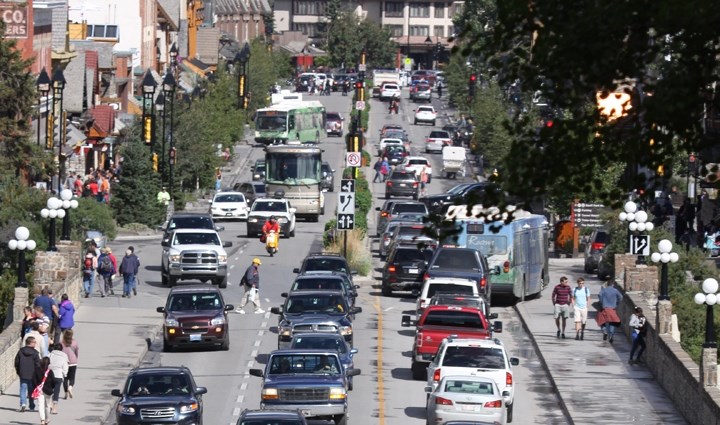An aerial gondola and intercept parking lots outside the Banff townsite to deal with traffic troubles seem unlikely to fly given Parks Canada’s concerns about development outside the townsite boundary.
Banff town council is getting public feedback on a new long-term transportation study that recommends mass transportation – either a $66 million aerial gondola or an $8 million bus system, with both ideas needing intercept lots at the two entrances to town in order to work.
Parks Canada officials say they are willing to work with the Town of Banff on solutions inside the town boundary to deal with Banff’s traffic problems, but indicate any development outside town, such as intercept parking lots or an aerial gondola, would be difficult to approve.
“There’s no doubt about it, solutions outside town boundaries would pose significant legal and environmental challenges,” said Sheila Luey, manager of land use, planning and policy with Banff National Park.
“The Town of Banff is located in the montane and it’s an ecologically important and sensitive area. That was part of the thinking in managing the town’s impact on that by fixing the town’s boundary in the National Parks Act,” she added.
“In general terms, Parks Canada is supportive of solutions within the town boundary whatever the subject is, and we’re committed to working with the Town on finding those solutions.”
With Parks Canada’s mandate to increase visitation in Banff National Park every year, and with work done by Banff Lake Louise Tourism and other tourism bodies to promote Banff, the park has seen a jump in visitation to 3.8 million people a year.
Of the 3.8 million, 93 per cent are said to travel to Banff in a private vehicle. Two-way vehicle counts at both entrances to town put the number of vehicles in 2015 at 5.9 million, up nine per cent over the previous year.
Several measures have helped reduce the traffic delays along Banff Avenue, over the Bow River Bridge and on Mountain Avenue over the last couple of years, but the downside is traffic also backs up along Norquay Road.
A couple of years ago delays reached up to 90 minutes at times, while the municipality’s monitoring shows the longest timespan people were stuck in traffic on the recent Canada Day long weekend was up to 22 minutes.
“We just can’t move any more vehicles. The roadways are beyond capacity. There is no more we can do to improve the road system,” said Adrian Field, manager of engineering for the Town of Banff.
“We’d like to try to get those delays down as low as we possibly can because it has negative impacts on visitor experience and residents getting around the town, and on emergency response times as well.”
The transportation study recommend the Town of Banff work with Parks Canada to expand the Fenlands recreation centre lot and create a new park-and-ride lot along Banff Avenue, known as Elk Woods.
Parks Canada has consistently said no to Elk Woods over the years, noting it lies within a wildlife corridor for several species, including large carnivores like bears and wolves. Elk also use the area as a refuge.
The transportation report estimates 1,000 parking stalls – 500 at both entrances to town – are needed in the short-term, while in the longer term it would need to be closer to 2,000 parking spaces.
According to the study, there would also need to be disincentives to get people to park at intercept lots, such as paid parking at premium downtown locations and at popular tourist attractions, plus displays of current vehicle delay times downtown.
The report also recommends the Town of Banff should undertake preliminary design work on conventional bus mass transit and on an aerial gondola, which would start downtown and terminate at Parks Canada’s hot springs and the Sulphur Mountain gondola.
Of the three alignments proposed for the gondola, the Town of Banff favours a 3.9 kilometre option, with five stations connecting downtown with Tunnel Mountain trailhead, the Banff Centre, Banff Springs Hotel and the Brewster gondola and Parks’ hot springs.
“With aerial transit you can move a significant amount of people and reduce congestion on roads. It’s a transportation system which is on time, it’s frequent and it goes from A to B,” said Field.
“There would be environmental and visual impacts that would need further consideration if this is something we would consider further.”
According to the study, enhancements to Banff’s public bus transit would require between eight and 11 buses in the short-term to deal with congestion and between 20 and 28 buses by 2045.
Field said there would need to be a big shift in the number of people catching buses, with research indicating only three per cent of people travelling across the Bow River Bridge are in a bus.
“Ridership is up nine per cent, but that’s in line with the vehicle volume increase,” said Field.
Council unanimously voted to send the long-term transportation study out for public feedback.
“We’ve hit capacity, which means during summer as we move on through time, the risk of catastrophic failure increases,” said Councillor Stavros Karlos. “There’s going to be days we hit gridlock. That’s an awful visitor experience and awful resident experience.”




